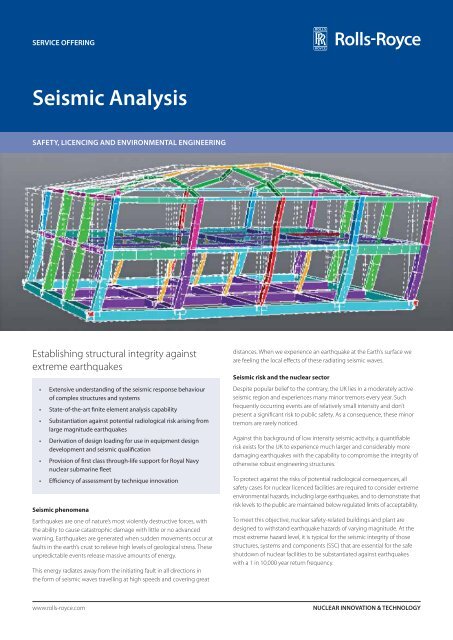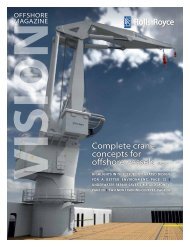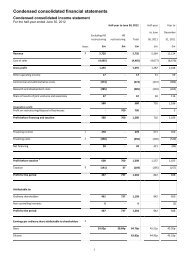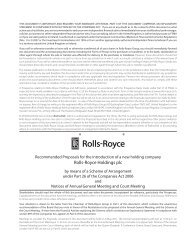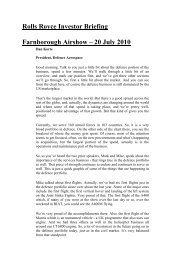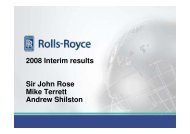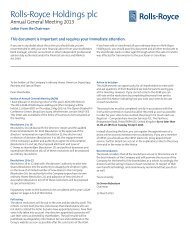Seismic Analysis - Rolls-Royce
Seismic Analysis - Rolls-Royce
Seismic Analysis - Rolls-Royce
Create successful ePaper yourself
Turn your PDF publications into a flip-book with our unique Google optimized e-Paper software.
SERVICE OFFERING<br />
<strong>Seismic</strong> <strong>Analysis</strong><br />
SAFETY, LICENCING AND ENVIRONMENTAL ENGINEERING<br />
Establishing structural integrity against<br />
extreme earthquakes<br />
<br />
<br />
<br />
<br />
<br />
<br />
<br />
<br />
<br />
<br />
<strong>Seismic</strong> phenomena<br />
Earthquakes are one of nature’s most violently destructive forces, with<br />
the ability to cause catastrophic damage with little or no advanced<br />
warning. Earthquakes are generated when sudden movements occur at<br />
faults in the earth’s crust to relieve high levels of geological stress. These<br />
unpredictable events release massive amounts of energy.<br />
This energy radiates away from the initiating fault in all directions in<br />
the form of seismic waves travelling at high speeds and covering great<br />
distances. When we experience an earthquake at the Earth’s surface we<br />
are feeling the local effects of these radiating seismic waves.<br />
<strong>Seismic</strong> risk and the nuclear sector<br />
Despite popular belief to the contrary, the UK lies in a moderately active<br />
seismic region and experiences many minor tremors every year. Such<br />
frequently occurring events are of relatively small intensity and don’t<br />
present a significant risk to public safety. As a consequence, these minor<br />
tremors are rarely noticed.<br />
Against this background of low intensity seismic activity, a quantifiable<br />
risk exists for the UK to experience much larger and considerably more<br />
damaging earthquakes with the capability to compromise the integrity of<br />
otherwise robust engineering structures.<br />
To protect against the risks of potential radiological consequences, all<br />
safety cases for nuclear licenced facilities are required to consider extreme<br />
environmental hazards, including large earthquakes, and to demonstrate that<br />
risk levels to the public are maintained below regulated limits of acceptability.<br />
To meet this objective, nuclear safety-related buildings and plant are<br />
designed to withstand earthquake hazards of varying magnitude. At the<br />
most extreme hazard level, it is typical for the seismic integrity of those<br />
structures, systems and components (SSC) that are essential for the safe<br />
shutdown of nuclear facilities to be substantiated against earthquakes<br />
with a 1 in 10,000 year return frequency.<br />
www.rolls-royce.com<br />
NUCLEAR INNOVATION & TECHNOLOGY
Analytical expertise<br />
As the designated design authority for generations of nuclear steam<br />
raising plant (NSRP) powering the Royal Navy fleet of nuclear submarines,<br />
<strong>Rolls</strong>-<strong>Royce</strong> has an excellent understanding of Pressurised Water Reactors<br />
(PWR) and related equipment and systems, their operational and safety<br />
functions and their behaviour under dynamic loading conditions.<br />
In support of nuclear site safety cases, <strong>Rolls</strong>-<strong>Royce</strong> has developed extensive<br />
knowledge and experience in the seismic analysis and integrity assessment<br />
of safety-related structures and components in<br />
the NSRP, associated fuel-handling and<br />
maintenance equipment and civil<br />
engineering structures.<br />
Reactor access house<br />
Example applications<br />
<br />
<br />
<br />
<br />
<br />
<br />
Where practicable, alternative seismic assessment techniques are adopted<br />
which can introduce significant timescale and cost benefits. One such<br />
approach is the seismic walkdown screening method employing the<br />
generic implementation procedures (GIP) for equipment qualification, as<br />
developed by the seismic qualification utilities group (SQUG).<br />
Innovation<br />
<strong>Rolls</strong>-<strong>Royce</strong> has earned a reputation for being an industry innovator with<br />
a track record based on the successful implementation of cutting edge<br />
solutions to a broad range of engineering challenges. However, not all<br />
innovations depend on increasing analytical complexity. A recent example<br />
is the development of a simplified procedure for seismic assessment and<br />
qualification of small bore piping.<br />
The method is based on first principle pipe bending calculations and<br />
permits assessment of complex piping layouts by breaking them down<br />
into a series of conservatively simplified piping spans.<br />
Dynamic structural loads and stresses resulting from seismic events are<br />
obtained by employing a range of industry standard analysis techniques,<br />
including:<br />
<br />
<br />
<br />
<br />
<br />
<br />
The first two approaches are ideally suited to determining the seismic<br />
response of linear dynamic structures, while the third technique can<br />
be applied to solve problems that involve both linear and non-linear<br />
behaviour.<br />
<strong>Rolls</strong>-<strong>Royce</strong> has considerable experience in the interpretation, analysis<br />
and manipulation of dynamic signal data. In-structure transient solutions<br />
derived using either of the two time history analysis methods are<br />
commonly subject to numerical processing to create secondary response<br />
spectra. In turn, these are used to define localised seismic loading for<br />
design and assessment of components or sub-systems. Synthetic time<br />
histories are also generated to match with design spectra, as and when<br />
required.<br />
Astute class small bore<br />
piping finite element models<br />
<br />
<br />
<br />
<br />
Applying this approach has delivered dramatic cost savings and major<br />
reductions to the lengthy timescales previously associated with such<br />
large-volume analysis tasks.<br />
7406/SO.27/Nov10<br />
<strong>Rolls</strong>-<strong>Royce</strong> Power Engineering plc<br />
PO Box 2000, Derby DE21 7BD, England<br />
Tel: +44 (0)1332 632688<br />
Fax: +44 (0)1332 622936<br />
Email: nuclearsolutions@rolls-royce.com<br />
www.rolls-royce.com<br />
© 2010 <strong>Rolls</strong>-<strong>Royce</strong> plc<br />
Whilst this information is given in good faith, no<br />
warranty or representation is given concerning such<br />
information, which must not be taken as establishing<br />
any contractual or other commitment binding upon<br />
<strong>Rolls</strong>-<strong>Royce</strong> plc or any of its subsidiary companies.


